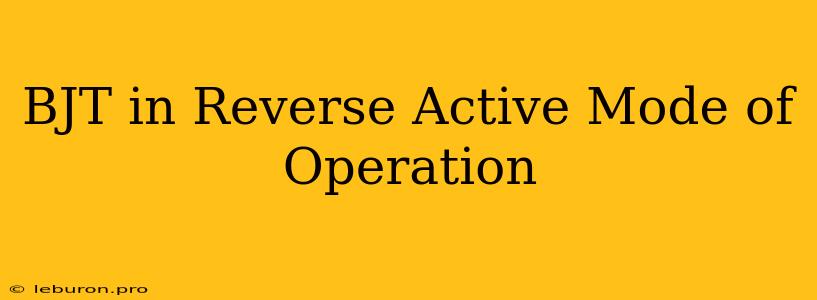The Bipolar Junction Transistor (BJT) is a widely used semiconductor device known for its versatility in various electronic circuits. While commonly operated in the forward active mode for amplification, the BJT can also operate in the reverse active mode. Although less common, this mode exhibits unique characteristics that can be harnessed for specific applications. This article delves into the concept of BJT in reverse active mode of operation, exploring its characteristics, applications, and potential advantages and disadvantages.
Understanding the Reverse Active Mode
The traditional forward active mode of operation for a BJT involves biasing the base-emitter junction forward and the base-collector junction reverse. This configuration allows for current amplification from the base to the collector. In contrast, the reverse active mode operates with the base-collector junction forward-biased and the base-emitter junction reverse-biased. This seemingly reversed configuration leads to a distinct set of characteristics, altering the transistor's behavior.
The Key Differences
-
Current Flow: In the reverse active mode, the emitter acts as the collector, and the collector acts as the emitter. This means that the majority carriers flow from the emitter to the collector, opposite to the forward active mode.
-
Current Gain: The current gain, denoted by β, is significantly lower in reverse active mode compared to forward active mode. This is because the emitter region is typically more heavily doped than the collector region, leading to a smaller number of minority carriers available for amplification.
-
Voltage Drop: The base-collector junction, now forward-biased, experiences a smaller voltage drop compared to the reverse-biased base-emitter junction in the forward active mode.
-
Leakage Current: The reverse-biased base-emitter junction exhibits a higher leakage current than the forward-biased base-collector junction in the reverse active mode.
Applications of Reverse Active Mode
Despite its lower current gain and higher leakage current, the reverse active mode finds specific applications in certain circuits:
-
High-Frequency Applications: Due to the reduced capacitance of the reverse-biased base-emitter junction, BJTs operating in reverse active mode can achieve higher operating frequencies compared to forward active mode. This makes them suitable for high-speed switching circuits.
-
High-Voltage Applications: The higher breakdown voltage of the reverse-biased base-emitter junction allows BJTs in reverse active mode to handle larger voltage swings, making them suitable for circuits operating at high voltages.
-
Special-Purpose Amplifiers: The lower current gain can be advantageous in certain applications where precise current control is needed. This can be useful in specialized amplifiers or current sources.
-
Current Mirrors: Reverse active mode can be used to create current mirrors, which are circuits that replicate a current accurately. The lower current gain helps in achieving precise current matching.
Advantages and Disadvantages
Advantages:
- High Frequency Operation: As mentioned earlier, the reduced capacitance allows for higher operating frequencies.
- High Voltage Handling: The reverse-biased base-emitter junction can withstand higher voltage swings.
- Precise Current Control: The lower current gain can provide finer control over current in specific applications.
Disadvantages:
- Lower Current Gain: The lower current gain reduces amplification capabilities, which may be undesirable in many standard amplifier circuits.
- Higher Leakage Current: The reverse-biased base-emitter junction contributes to increased leakage current, potentially affecting the performance of sensitive circuits.
- Limited Availability: Transistors are not always designed to be optimal for reverse active operation, limiting their practical use in some cases.
Conclusion
Operating a BJT in reverse active mode introduces a different set of characteristics that can be advantageous in specific scenarios. While its lower current gain and higher leakage current limit its applicability in many traditional amplifier designs, BJT in reverse active mode proves useful for high-frequency, high-voltage, and specialized current control applications. Understanding these characteristics and potential benefits allows engineers to explore the full range of possibilities offered by this versatile semiconductor device.
